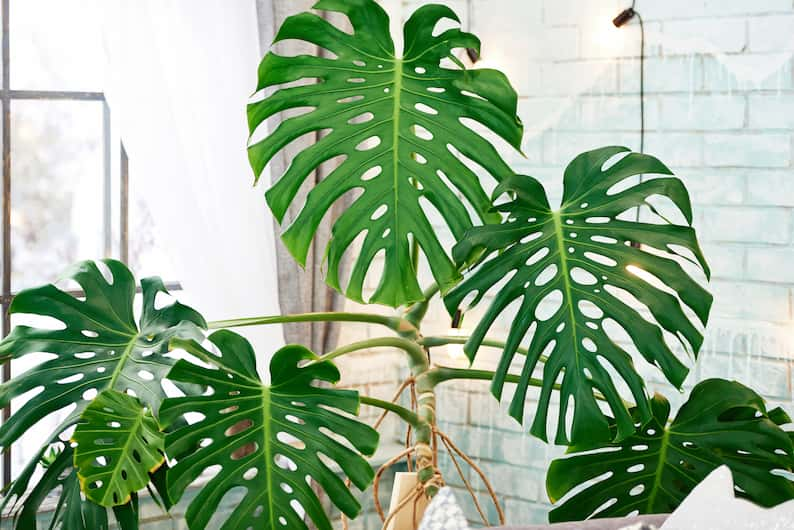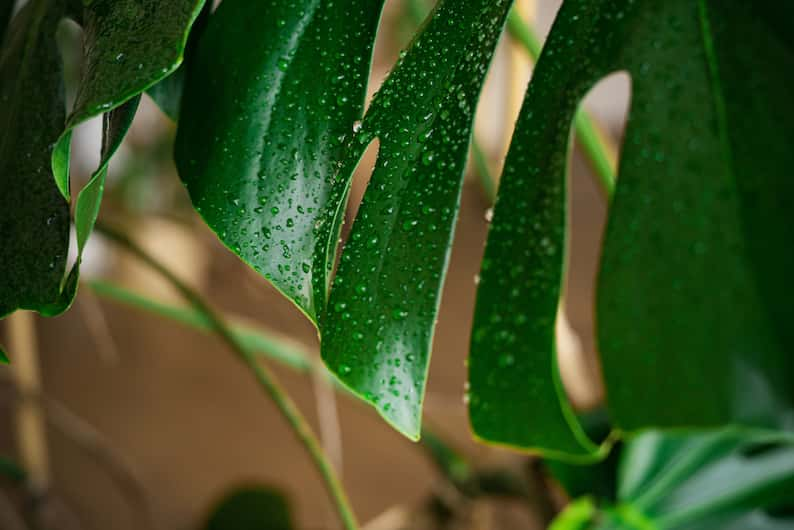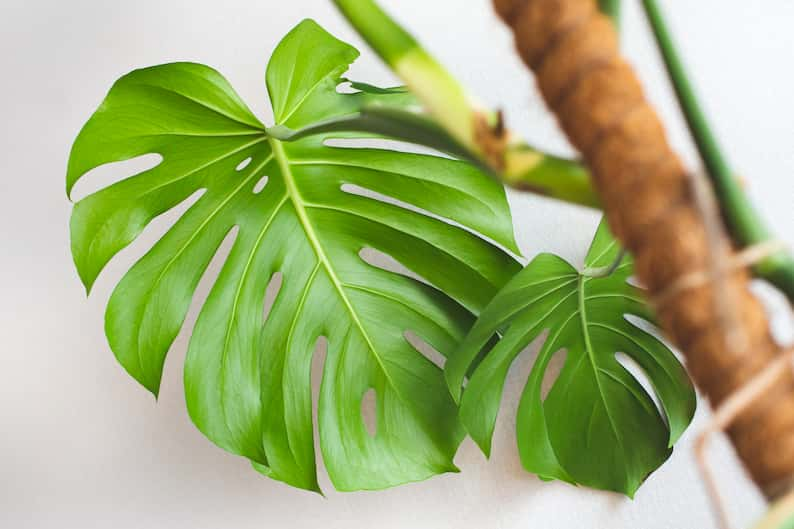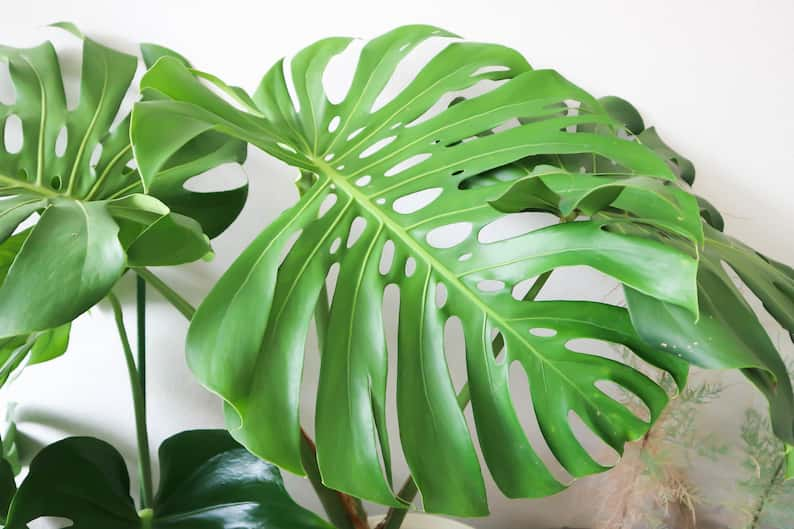If your Monstera deliciosa plant has grown to gigantic proportions, congratulations on what is almost certainly some excellent care of your Swiss Cheese plant! At the same time, giant Monstera care has the tendency to come with a whole new set of challenges – nothing that you won’t be able to handle though, of course.
That is, these gentle monsters are only doing what they do best and reaching for the sky. By mimicking their natural environment, you can help them reach their potential and keep your large Monstera plant happy and healthy in your home.
You must be doing something right though as the fact you have a Monstera that’s this big means it’s obviously happy and healthy as it strives to attain its mature height and size. Keep in mind that when Monstera are in the wild, they grow on the forest floor in rainforests and climb trees to reach the canopy’s light. In fact, they may grow to heights of 50 feet or more in the wild – not ideal for your lounge room, presumably!
So understanding the basic care needs of large Monstera plants and adapting how you respond to these is key to your success with managing your giant Monstera indoors. This includes adequate light, well-drained soil, and proper watering. And, of course, there are some tips and tricks to managing its enormous size, too – so keep reading to find out just what these are.

Table of Contents
How do you take care of a giant Monstera plant?
Taking care of a giant Monstera plant involves ensuring its basic needs continue to be met despite its large size, like providing rich, well-draining soil, plenty of bright indirect light, and soil that dries out slightly between waterings. You should also make sure it has a pole to climb given its height and the fact it can’t support itself.
In particular, make sure you’re keeping an eye on the following.
1. Basic Monstera care
As mentioned, like all Monsteras, your giant Monstera plant has some unique growing preferences that shouldn’t be ignored. It needs rich, well-draining soil, plenty of bright indirect light, and soil that dries out slightly between waterings. It also requires the support of a moss-covered pole or totem to keep your climbing Monstera happy.
2. Right sized pot
You may find it challenging to keep up with the watering needs of a large Monstera plant, but the problem is twofold. A smaller pot dries out quickly as the large plant absorbs moisture and nutrients from the soil. However, repotting your Monstera plant into a large pot encourages the plant to grow larger.
If you have room for the plant to grow and want to reduce the frequency of watering your Monstera plant, repotting it to a larger plant pot is an excellent alternative. Because there is more soil in the large pot, it can hold more water and dries out more slowly.
Related: Here’s the Best Pot for Your Monstera
3. Adding a larger pole
If your plant has grown so large that your Monstera’s moss pole or totem isn’t providing enough support, adding an additional pole or support will help stabilize it. The best way to accomplish this is to add another stake or trellis to give extra support. You could remove and replace the current pole, but this can be risky with a heavy plant.
Instead, consider attaching a new pole to the back of the plant pot or place the plant in a corner or against a wall with lattice or other supports against the wall. This will allow the plant to grow and give it the support it needs. See how to stake a Monstera with an extra pole here.
How do you grow a giant Monstera plant?
You can grow a giant Monstera plant by fully taking care of your plant’s needs. This means ensuring it’s getting bright, indirect light, has an appropriately sized pot that allows it to grow without being too big and is being watered at the right frequency.

That is, a lot of people looking to grow a large Monstera plant are tempted to put them in much bigger pots, on the understanding that this gives your plant the space to grow as big as you want it to.
Unfortunately, this can have the opposite effect. A pot that’s too big can actually hurt your plant, including that it can lead to the soil retaining too much moisture, leading to your Monstera being overwatered. As a worst case scenario, this can actually kill your plant and will definitely stop it from growing, so make sure you’re sticking to pots that are the right size.
When should I water a giant Monstera?
Much like other sizes of this plant, giant Monsteras need to be watered once or twice a week when it is actively growing in spring and summer. It may, however, be fine for a week or two during the fall and winter.
They prefer well-drained soil that dries out slightly between waterings. They should be watered when the soil feels dry to the touch, about 1 to 2 inches below its surface.
How often you need to water a giant Monstera that’s indoors depends on the size of the pot, your Monstera’s growth rate and health, and the time of year. Overall, though, make sure you’re checking the soil moisture before watering it, as that’s always the best indicator.
Why is my Monstera so big?
Monsteras get their name from the Latin word monstrum, meaning monster or enormous. While some think this refers to the leaves, it also describes these giants in the wild. In their native environment, large Monstera plants can reach heights of 50 feet or more and so will also get quite big as houseplants when they’re well looked after.

In nature, they continue to grow upwards as they reach for the sky and climb to the canopy of the rainforest. So while they don’t grow this large when grown as a houseplant, these plants are naturally large.
Under ideal conditions, Monstera plants get bigger as they mature, producing larger leaves and a heavier stalk. Take note though that not all types of Monsteras become enormous, as some are quite happy sticking to their much smaller, more contained sizes.
Related: How Long Do Monsteras Take To Grow (and How to Speed It Up)?
How can I slow the growth of my giant Monstera?
Slowing down the growth of your giant Monstera involves controlling the conditions that cause it to grow rapidly in the first place. Pruning, providing less light, and reducing the fertilizer you give your Monstera plant will help slow down its growth and help maintain a smaller plant.
1. Pruning
Prune your giant Monstera plant to maintain its height and size. These plants can be trimmed without damage to the plant and can be cut at nearly any point. What’s important is to trim them just above a leaf node or trim them back to the main stem for the best appearance.
You can use your giant Monstera cutting to start a new plant by growing your Monstera cutting in water (although take note that you can’t propagate Monstera without a node). Keep in mind that giant Monstera propagation from stem cuttings will produce a plant identical to the parent plant. Unless you take steps to control its size, it is likely to grow into a huge plant, too.
2. Root pruning
Monstera plants send out new roots to fill the pot every time you repot them. This encourages new plant growth, too. To keep your Monstera plant from going through massive growth spurts, you can prune the roots and repot them in the same pot when you need to refresh the soil.
Cut the roots back by no more than one-third and repot it in the same pot to keep your Monstera plant from growing too large.

3. Less light
In terms of how much light your Monstera needs, these plants thrive in bright indirect light, but their growth slows naturally if they receive less light. If your Monstera plant is becoming overgrown and you want to slow it down, move it to an area that receives less light.
4. Reduce fertilizer
Tall Monstera plants need nutrients to thrive and benefit from a balanced plant fertilizer like other houseplants. However, fertilizing your Monstera plant regularly encourages lush, new growth. If your Monstera plant is healthy and growing rapidly, reduce the frequency of fertilizing the plant to slow it down.
How big does a Monstera deliciosa get?
Monstera deliciosa plants can reach an amazing height in the wild and often grow to 50 feet or more. They don’t grow this big inside, of course, but they can reach heights of 10 to 15 feet with a spread of 8 feet. These huge plants often produce mature leaves that are 18 inches wide.
Where do you put a giant Monstera?
A giant Monstera does best when it is grown against a wall that provides additional support for the plant. It can be placed in a corner with plenty of room to spread out as it grows. These attractive plants are often grown in offices and waiting rooms and used as dividers or to enclose a seating area.

How do you repot a giant Monstera?
Repotting a giant Monstera can be a challenge due to its impressive size. Before you attempt this task, enlist the help of one or two people so you can support the plant properly and avoid damage when repotting your Monstera.
- Water your Monstera plant thoroughly the day before you intend to repot it. This ensures the plant is well hydrated and reduces stress to the plant. It also makes the soil easier to work with.
- Choose a location for repotting your large Monstera plant. If weather permits, putting your Monstera outside may be the best choice. Otherwise, choose an area with enough room to lay the plant down comfortably.
- Spread a tarp or blanket over the area to protect floors or carpets.
- Gently lay the entire plant down on its side.
- Loosen the soil in the pot by squeezing the sides or running a blunt object like a butter knife around the inside rim.
- Work with a helper to remove the plant from the pot with one (or more) people holding the plant’s main stalk and another holding the roots. You may wish to have a third person guide its pole.
- Rinse the loose soil away from the roots. If rinsing is not practical, use your hands to clear the soil away from the roots gently.
- Fill the new pot about halfway with fresh potting soil.
- Gently position the roots of your giant Monstera plant into the new pot and backfill around the roots with fresh soil.
- Firm the soil down firmly to secure the plant and the pole.
- Replace the plant in its original location.
Growing a giant Monstera plant can be a lot of fun, but sometimes you just don’t have room for a huge plant. When yours begins to outgrow its space, it is time to take measures to maintain its size and slow down its growth.
You can do this by pruning, reducing the amount of light it receives and cutting down on the fertilizer you give your giant Monstera plant.
On the other hand, if you have the space, why not embrace its size! It’s a sign that you’re a very successful plant parent and there’s no question that a houseplant this big will be a showstopper in any room.
